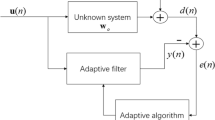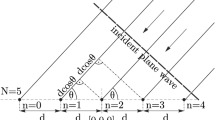Abstract
The performance of a 4-QAM indoor wireless data communication system with adaptive equalizer is investigated. The effectiveness of using linear and decision-feedback equalizer for Rayleigh and Rician frequency-selective indoor channels is evaluated, and contrasted to the performance of a 4-QAM modem without equalizer. The effects of some important channel and system parameters (multipath spreads up to 200 ns, data rates up to 25 Mbit/s, signaling pulse rolloff factor between 0.5 and 1.0, and additive, white Gaussian noise) on the indoor communication system performance are examined and presented in the paper. The indoor propagation measurements, carried out in a research laboratory, provided data to be used for BER performance assessments of the system with and without equalizer. The performance results based on computer generated channels are then compared with those obtained for measured channel impulse responses.
Similar content being viewed by others
References
Aghvami, A.H., I.D. Robertson, and S.A. Mohamed: “High bit-rate indoor radio communications”, in Proc. Third IEE Conf. on Telecom, pp. 101–106, Edinburgh, 1991.
Alexander, S.E.: “Radio propagation within buildings at 900 MHz”, Electronic Letters, Vol. 18, pp. 913–914, 1982.
Alexander, S.E.: “Characterising buildings for propagation at 900 MHz”, Electronic Letters, Vol. 19, pp. 860, 1983.
Devasirvatham, D.M.J.: “Time delay and signal level measurements of 850 MHz radiowaves in building environment”, IEEE Trans., Vol. AP-34, pp. 1300–1305, 1986.
Bultitude, R.J.C.: “Measurement, characterization and modeling of indoor 800/900 MHz radio channels for digital communications”, IEEE Com. Mag., Vol. 25, pp. 5–12, 1987.
Arnold, H.W., R.R. Murray and D.C. Cox: “815 MHz radio attenuation measured within two commercial buildings”, IEEE Trans., Vol. AP-37, pp. 1335–1339, 1989.
Bultitude, R.J.C., S.A. Mahmoud and W.A. Sullivan: “A comparison of indoor radio propagation characteristics at 910 MHz and 1.75 GHz”, IEEE J. on Selected Areas in Commun., Vol. SAC-7, pp. 20–30, 1989.
Devasirvatham, D.M.J., C. Banarjee, M.J. Crain, D.A. Rappaport: “Multifrequency radiowave propagation measurements in the portable radio environment”, IEEE Int. Conf. on Commun. (ICC'90) Proceedings, Atlanta, Vol. 4, pp. 335.1.1–7.
Stigter, P.A.: “Indoor propagation measurements at 2.4 GHz, 4.75 GHz and 11.5 GHz, performed at TNO-FEL”, TNO Report, No. FEL-92–S075, 1992.
Molkdar, D.: “Review on radio propagation into and within buildings”, IEE Proceedings H, Vol. 138, No. 1, pp. 61–73, 1991.
Winters, J.H. and Y.S. Yeh: “On the performance of wideband digital radio transmission within buildings using diversity”, IEEE GLOBECOM Proceedings, pp. 32.5.1–6, 1985.
Mitzlaff, J.E.: “Radio propagation and anti-multipath techniques in the WIN environments”, IEEE Network Magazine, Vol. 5, No. 6, pp. 21–26, 1991.
Saleh, A.A.M. and L.J. Cimini, Jr.: “Indoor radio communications using time-division multiple access with cyclical slow frequency hopping and coding”, IEEE J. on Selected Areas in Commun., Vol. SAC-7, pp. 59–70, 1989.
Kavehrad, M.: “Performance of nondiversity receivers for spread spectrum in indoor wireless communications”, B.S.T.J., Vol. 64, pp. 1181–1210, 1985.
Kavehrad, M. and P.J. McLane: “Performance of low-complexity channel coding and diversity for spread spectrum in indoor wireless communication”, B.S.T.J., Vol. 64, pp. 1927–1965, 1985.
Kavehrad, M. and B. Ramamurthi: “Direct-sequence spread spectrum with DPSK modulation and diversity for indoor wireless communications”, IEEE Trans., Vol. COM-35, pp. 224–236, 1987.
Prasad, R., H.S. Misser and A. Kegel: “Performance analysis of direct-sequence spread-spectrum multiple-access communication in an indoor rician-fading channel with DPSK modulation”, Electronic Letters, Vol. 26, pp. 1366–1367, 1990.
Misser, H.S., C.A.F.J. Wijffels and R. Prasad: “Throughput analysis of CDMA with DPSK modulation and diversity in indoor Rician fading radio channels”, Electronic Letters, Vol. 27, pp. 601–603, 1991.
Sexton, T.A. and K. Pahlavan: “Channel modeling and adaptive equalization of indoor radio channels”, IEEE J. on Selected Areas in Commun., Vol. SAC-7, pp. 114–120, 1989.
Valenzuela, R.A.: “Performance of adaptive equalization for indoor radio communications”, IEEE Trans., Vol. COM-37, pp. 291–293, 1989.
Pahlavan, K., S.J. Howard, and T.A. Sexton: “Decision feedback equalization of the indoor radio channel”, IEEE Trans., Vol. COM-41, pp. 164–170, 1993.
Zigic, A. and R. Prasad: “Computer simulation of indoor data channels with a linear adaptive equaliser”, Electronic Letters, Vol. 26, pp. 1596–1597, 1990.
Zigic, A. and R. Prasad: “Computer simulation of a 4-QAM indoor data communication system with a linear adaptive equaliser”, in Proc. Third IEE Conf. on Telecom., pp. 95–100, Edinburgh, 1991.
Zigic, A. and R. Prasad: “Bit error rate of decision feedback equaliser for indoor wireless communications”, Electronic Letters, Vol. 28, pp. 1949–1950, 1992.
Zigic, A., M.J. Krapels and G.J.M. Janssen: “Performance evaluation of adaptive equalization for measured indoor radio channels at 2.4 GHz, 4.75 GHz and 11.5 GHz”, in Proc. IEEE First Symposium on Commun, and Veh. Tech. in the Benelux, pp. 3.5–1–3.5–8, Delft, 1993.
Saleh, A.A.M. and R.A. Valenzuela: “A statistical model for indoor multipath propagation”, IEEE J. on Selected Areas in Commun., Vol. SAC-5, pp. 128–137, 1987.
Rappaport, S.T. and C.D. McGillem: “UHF fading in factories”, IEEE J. on Selected Areas in Commun., Vol. SAC-7, pp. 40–48, 1989.
Cox, D.C.: “Delay doppler characteristics of multipath propagation at 910 MHz in a suburban mobile radio environment”, IEEE Trans., Vol. AP-20, pp. 625–635, 1972.
Gitlin, R.D. and S.B. Weinstein: “Fractionally-spaced equalization: An improved digital transversal equalizer”, B.S.T.J., Vol. 60, pp. 275–296, 1981.
Clark, M.V., L.J. Greenstein, W.E. Kennedy and M. Shafi: “Matched filter performance bounds for diversity combining receivers in digital mobile radio”, IEEE Trans., Vol. VT-41, pp. 356–362, 1992.
Belfiore, C.A. and J.H. Park Jr.: “Decision feedback equalization”, Proceedings of the IEEE, Vol. 67, pp. 1143–1156, 1979.
Duttweiler, L.D., J.E. Mazo and D.G. Messerschmitt: “An upper bound on the error probability in decision-feedback equalization”, IEEE Trans., Vol. IT-20, pp. 490–497, 1974.
Monsen, P.: “Adaptive equalization of the slow fading channel”, IEEE Trans., Vol. COM-22, pp. 1064–1075, 1974.
Proakis, J.G.: Digital Communications, New York: McGraw-Hill, 1989, 2nd ed.
Clark, A.P.: Adaptive Detectors for Digital Modems, London: Pentech Press, 1989.
Qureshi, S.U.H.: “Adaptive equalization”, Proceedings of the IEEE, Vol. 73, pp. 1349–1387, 1985.
Howard, S.J. and K. Pahlavan: “Doppler spread measurements of the indoor radio channels”, Electronic Letters, Vol. 26, pp. 107–108, 1990.
Hashemi, H.: “The indoor propagation channel”, Proc. of the IEEE, vol. 81, pp. 943–967, 1993.
Proakis, J.G.: “Adaptive equalization for TDMA digital mobile radio”, IEEE Trans., Vol. VT-40, pp. 333–341, 1991.
Author information
Authors and Affiliations
Rights and permissions
About this article
Cite this article
Zigic, A. Adaptive equalization for high-speed indoor wireless data communication. Wireless Pers Commun 1, 229–251 (1994). https://doi.org/10.1007/BF01099777
Issue Date:
DOI: https://doi.org/10.1007/BF01099777




